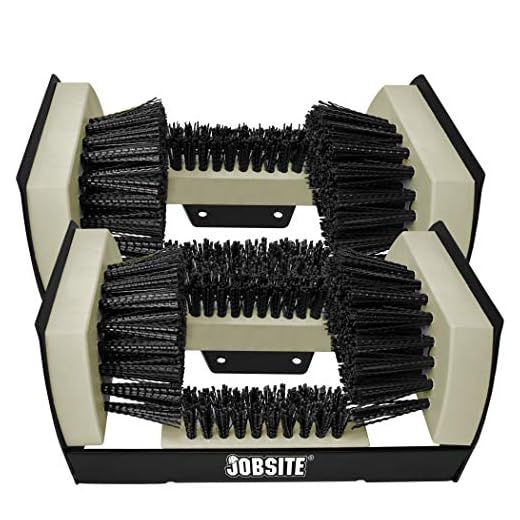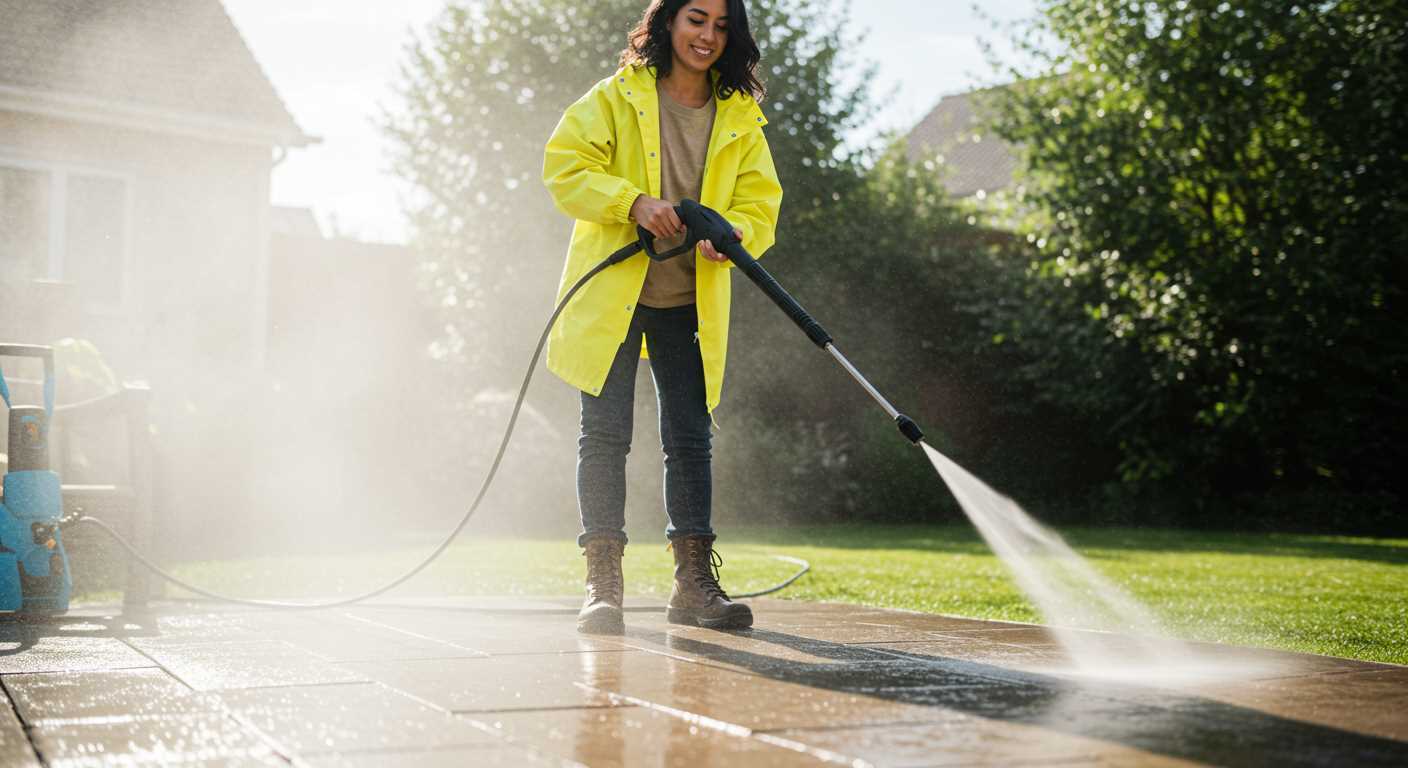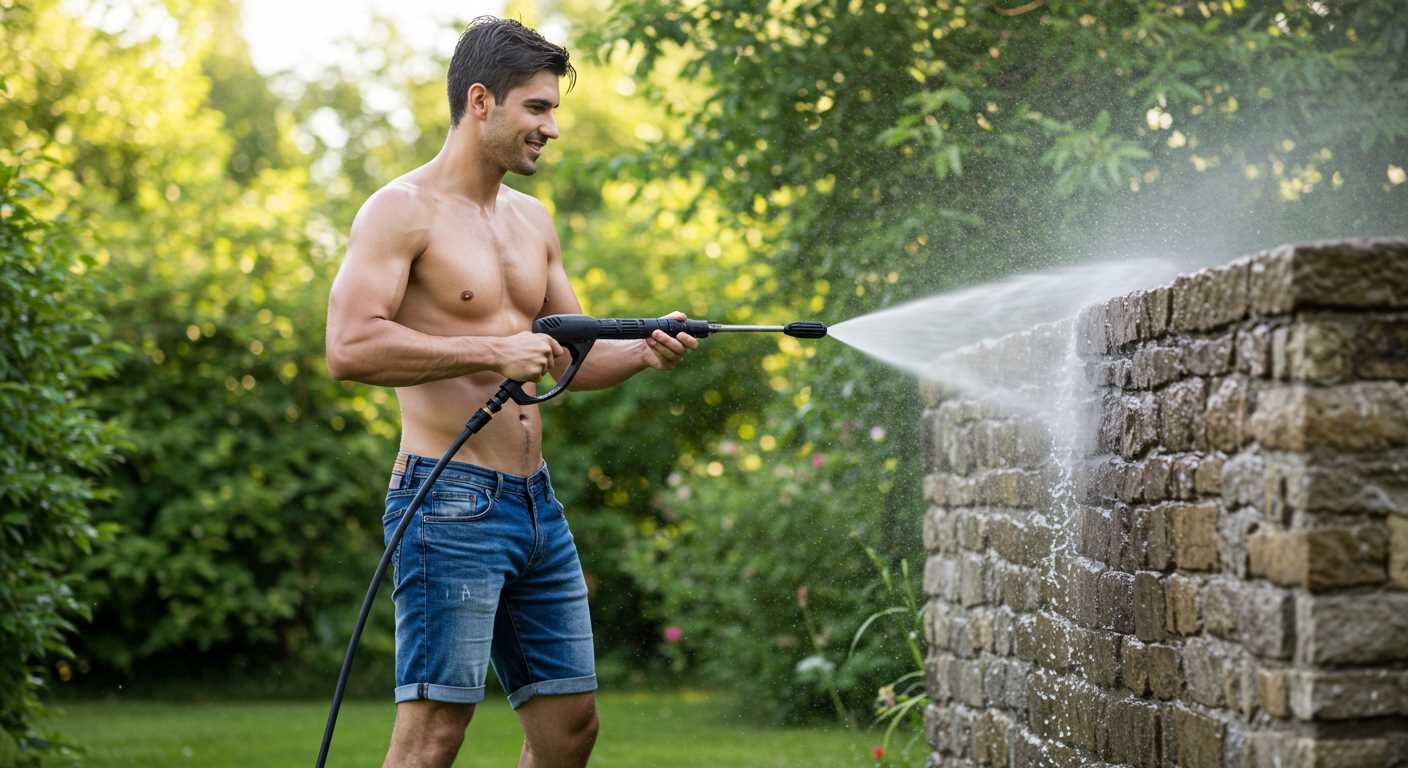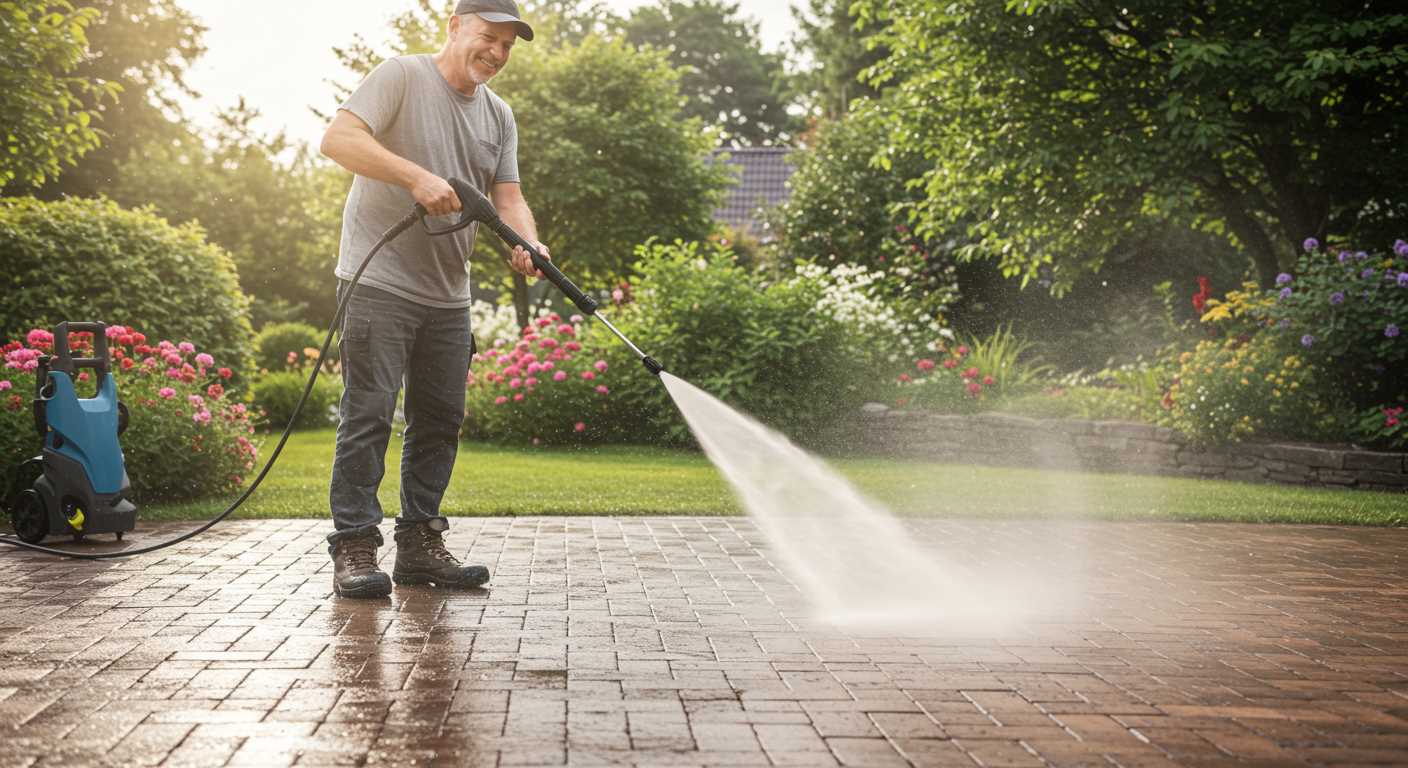



For effective restoration of outdoor surfaces, particularly those made from concrete, I recommend employing a machine with a minimum force of 3000 pounds per square inch. This level of intensity enables the removal of deeply embedded dirt, oil stains, and mildew that can accumulate over time. Using equipment below this benchmark may result in inadequate cleaning, requiring multiple passes and additional effort.
Additionally, consider a model that offers a flow rate of at least 2.5 gallons per minute. This specification not only enhances the rinsing process but also ensures that the detergent penetrates and breaks down stubborn contaminants more efficiently. The synergy between pressure and water flow is integral to achieving a pristine finish without damaging the surface.
Utilising the appropriate nozzle is also essential. A 15-degree or 25-degree spray tip is ideal for tackling tough grime, ensuring a focused stream that maximises cleaning potential. Prioritising these details will ensure a thorough cleanse, reviving the concrete to its original state while enhancing its appearance for years to come.
Understanding PSI and Its Importance for Concrete Cleaning

A range of 3000 to 4000 units is generally ideal to tackle stains on hard surfaces. This level of force effectively removes grime, oil spots, and other difficult residues. I recommend selecting a model that falls within this range to maximise your results.
Key Advantages of Appropriate Pressure Levels
- Effective Stain Removal: Higher units enhance the ability to eradicate tough marks and dirt, ensuring a thorough cleanse.
- Time Efficiency: Opting for a robust unit allows you to complete the task faster, saving valuable time.
- Ease of Use: Models with higher ratings typically come equipped with various nozzles, making it simpler to adapt to different surfaces.
Potential Risks of Excessive Pressure
- Surface Damage: Using too much force can etch or deteriorate the surface, causing long-term issues.
- Water Consumption: Higher ratings often lead to more water usage, which may be a concern in areas with restrictions.
- Safety Hazards: Excessive force can create flying debris, increasing the risk of injury during operation.
Balancing power with caution is vital to achieve optimal outcomes while preserving the integrity of the hard surfaces. Prioritising the right specifications ensures you can accomplish the task safely and effectively.
Recommended PSI Range for Different Concrete Types
Highly porous surfaces such as broom-finished concrete benefit from a cleansing unit operating at 2500 to 3000 units of pressure. This level ensures effective removal of debris and stains without causing damage.
Standard Concrete Finishes
.jpg)
For regular concrete finishes, a range of 2000 to 2500 units is ideal. This setting balances power and safety, allowing for thorough washing while preserving the integrity of the surface.
Textured Concrete and Stamped Surfaces
Textured or stamped concrete requires lower settings, typically between 1500 and 2000 units. This prevents any risk of chipping or wearing down the detailing while still delivering satisfactory results.
Choosing Between Electric and Gas Pressure Washers for Concrete
For tackling stubborn stains on surfaces, gas machines are my top recommendation. They typically deliver higher power levels and are ideal for large areas or heavily soiled concrete. With a pressure rating of 3000 PSI or more, these units excel in removing oil, grease, and mould that often cling to exterior surfaces.
Electric alternatives hold their ground in specific situations. With a range of 1300 to 2000 PSI, they efficiently handle light to moderate debris and are particularly suited for smaller jobs or residential tasks. They are quieter and more environmentally friendly, making them an excellent choice for those in suburban settings or with space limitations.
| Type | Pressure Range (PSI) | Best Suited For | Pros | Cons |
|---|---|---|---|---|
| Gas | 3000+ | Large areas, heavy stains | High power, mobility | Noise, maintenance |
| Electric | 1300-2000 | Small to medium tasks | Quiet, easy to store | Limited pressure, corded |
Maintenance varies significantly between these two types as well; gas machines require regular upkeep, including oil changes and air filter replacements, while electric models demand minimal attention. To sum it up, if your project involves tedious cleaning of expansive or heavily stained surfaces, opt for a gas machine. For lighter, more routine tasks, an electric unit will suffice and offer convenience.
Identifying the Right Nozzle for Concrete Cleaning

For optimal performance whilst tackling stains and grime on a hard surface, a nozzle with a narrow spray pattern is best. Specifically, I recommend a zero-degree or 15-degree nozzle. These options concentrate the water stream, delivering a powerful force that effectively dislodges dirt from porous concrete materials.
Understanding Nozzle Types
Each nozzle type serves a distinct purpose. The zero-degree nozzle generates the most intense pressure, making it perfect for stubborn stains like grease or oil. However, caution is advised; this intensity can damage the surface if not used correctly. The 15-degree nozzle offers a wider spray pattern, striking a balance between power and coverage, making it suitable for general cleaning tasks.
Considerations for Varying Conditions
Consider the nature of the concrete surface. For textured or stamped concrete, a wider nozzle, such as 25 or 40 degrees, may be more appropriate. This allows for thorough cleaning without the risk of causing surface damage. Always assess the specific requirements of your project to ensure the right nozzle choice, tailoring the application to the characteristics of the surface at hand.
Additional Cleaning Agents to Use with Pressure Washers
Adding specific cleaning solutions enhances the performance of a machine, especially on tougher grime and stains. For concrete surfaces, consider using a degreaser, specifically formulated for heavy-duty applications. These agents effectively break down oil, grease, and dirt, making them ideal prior to washing.
Choosing Detergents
Opt for biodegradable products to minimise environmental impact. Look for formulas that are safe for outdoor surfaces and do not harm surrounding plants or animals. Concentrated versions often yield better results with less product, allowing for efficient use during the process.
Mixing and Application
Follow manufacturer instructions regarding dilution ratios. In most cases, a mixture of one part cleaner to ten parts water is effective. Apply the solution with a low-pressure setting, allowing it to penetrate for a few minutes before rinsing with high pressure. This method ensures optimal dirt removal without damaging the surface.
Preparing Concrete Surfaces Before Pressure Washing
Remove any large debris such as leaves, branches, or stones from the area. Sweeping the surface thoroughly ensures that the washer operates smoothly without obstruction.
Inspect for any cracks or loose pieces. Fill the cracks with a concrete filler to prevent further damage during the wash. This step is crucial, especially in high-pressure situations, to maintain the integrity of the slab.
Consider using a garden hose to wet the surface beforehand. This can help to loosen dirt and grime, making the washing process more effective. Be mindful, however, not to oversaturate, as excessive moisture can lead to less effective results.
If the surface has stubborn stains, pre-treat them with specific cleaning solutions designed for concrete. Apply the solution generously and allow adequate time for it to penetrate the stains before starting the machinery.
Establish a safe perimeter around the area. Move any objects, plants, or furniture that could obstruct the workspace or get damaged during operation. This not only protects your belongings but also allows for a thorough clean.
Finally, ensure that all necessary safety gear is worn, including goggles and gloves, to safeguard against flying debris or chemical reactions with cleaning agents. Proper preparation creates an environment conducive to achieving optimal results without hazards.
Tips for Maintaining Your Cleaning Equipment
Regularly clean the intake filter. A clogged filter restricts water flow, reducing performance. Check it after every few hours of operation and rinse it under running water to remove debris.
Inspect hoses for cracks or kinks. A compromised hose can lead to leaks and reduced pressure. Replace any damaged sections immediately to ensure consistent output.
Always store your machine in a dry place. Moisture can lead to rust and corrosion, affecting internal components. Use a protective cover when storing outdoors.
Winterization Steps
Before the winter months, flush the system with antifreeze. It prevents water from freezing inside the pump, which can cause significant damage. Disconnect all attachments and let the machine run until antifreeze flows out of the nozzle.
Check the oil level regularly if your model has a lubrication system. Replace old oil as recommended by the manufacturer to keep the motor running smoothly.
Routine Checks
Test the pressure gauges periodically to ensure they are functioning correctly. If readings are inconsistent, recalibration may be necessary to maintain optimal efficiency.
Finally, always follow the user manual for specific maintenance tips tailored to your model. This will guide you in prolonging the lifespan of your equipment while maintaining peak performance.
Safety Precautions When Using a Pressure Washer on Concrete

Always wear protective gear before operating any high-pressure equipment. Essential items include safety goggles, gloves, and sturdy footwear to prevent slips.
Ensure the work area is clear of obstacles, debris, or any items that could become projectiles when water jets are released. Remove any furniture, vehicles, or equipment that might obstruct the area.
Check for electrical hazards before connecting your equipment. Verify that your extension cords are in good condition and rated for outdoor use to avoid electrical shocks.
Maintain a safe distance when directing the nozzle, particularly on uneven surfaces. Stand at least 2 feet away from the surface to avoid damage or injury from high-velocity water.
Monitor the surrounding environment. Be cautious of children, pets, or bystanders when operating as the force can inadvertently impact them.
Always operate the device with the correct nozzle attachment, as using an inappropriate one can lead to loss of control and potential accidents.
<p Ensure proper gearing alignment and functionalities of hose connections to avoid leaks during operation. Regularly inspect the equipment to prevent malfunctions that could pose risks.
Stay hydrated and take breaks to avoid fatigue, which can impair concentration and safety during the operation. Operating equipment while tired increases the chance of errors.
Lastly, adhere to the manufacturer’s operating instructions. Every model has specifics that must be followed to ensure safe and effective performance.









